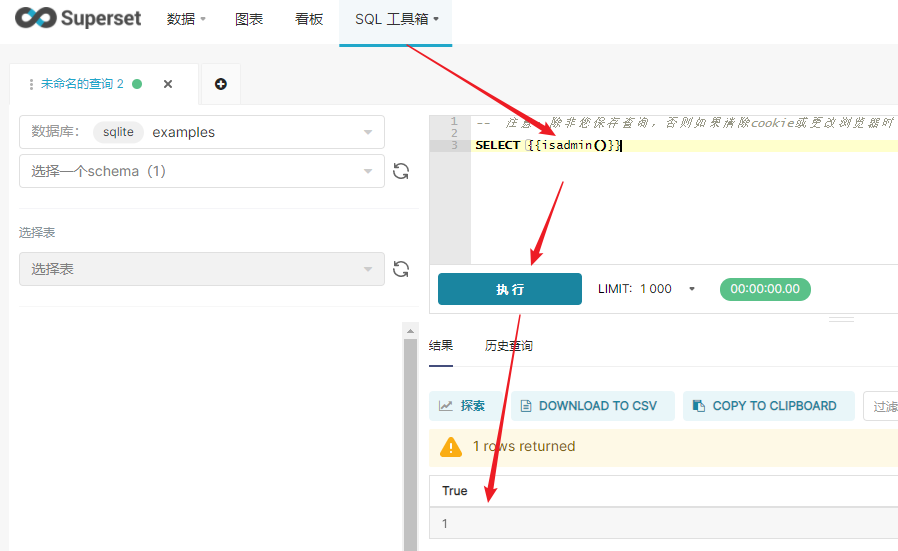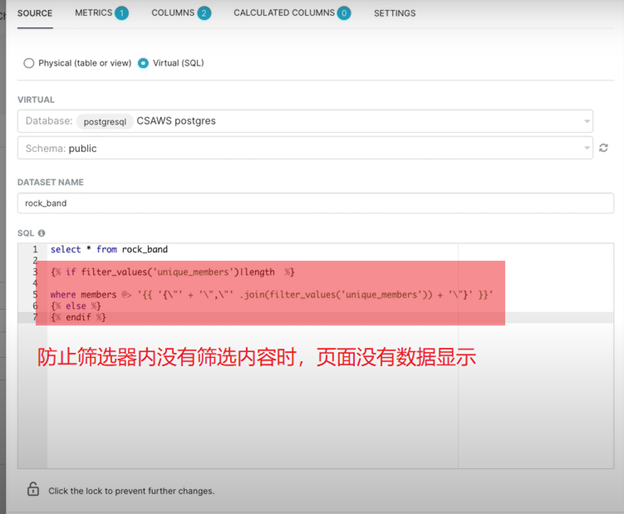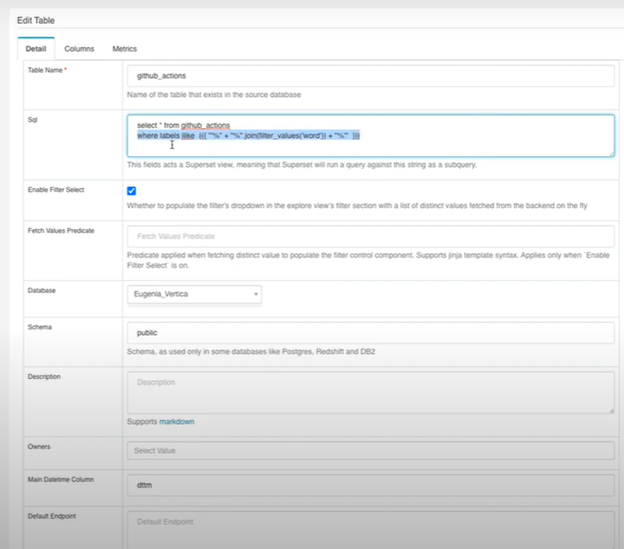使用自定义参数方式实现 superset 实现SQL动态查询
1、启用参数:config.py 设置”ENABLE_TEMPLATE_PROCESSING”: True
2、当前superset v1.2版本支持的参数包括:
{{ current_username() }} 当前登录用户名
{{ current_username(add_to_cache_keys=False) }} 不从缓存中获取登录用户名,默认从缓存获取
{{ current_user_id()}} 当前登录用户ID
{{ current_user_id(add_to_cache_keys=False) }} 不从缓存中获取登录用户ID,默认从缓存获取
{{ url_param(‘custom_variable’) }} url 参数,比如127.0.0.1:8001\dashboard?abc=123,参数就是{{ url_param(‘abc’) }} 结果就是123
{{ cache_key_wrapper() }} 还没有弄明白啥用
{{ filter_values(“字段名”) }} 获取dashboard filter_box组件对某个字段的筛选结果
{{ from_dttm }} 获取dashboard filter_box组件日期筛选的开始时间
{{ to_dttm }} 获取dashboard filter_box组件日期筛选的结束时间
{{ get_filters() }} 暂时没有弄明白
除此之外,还可以自定义参数,自定义参数方法:
①修改superset/jinja_context.py文件,修改三个地方:
regex = re.compile(
r"\{\{.*("
r"current_user_id\(.*\)|"
r"current_username\(.*\)|"
r"current_userroles\(.*\)|"
r"isadmin\(.*\)|"
r"cache_key_wrapper\(.*\)|"
r"url_param\(.*\)"
r").*\}\}"
)
↑↑↑↑注意此处的 current_userroles 和 isadmin 是我自定义的,源文件没有
def current_user_id(self, add_to_cache_keys: bool = True) -> Optional[int]:
"""
Return the user ID of the user who is currently logged in.
:param add_to_cache_keys: Whether the value should be included in the cache key
:returns: The user ID
"""
if hasattr(g, "user") and g.user:
if add_to_cache_keys:
self.cache_key_wrapper(g.user.get_id())
return g.user.get_id()
return None
def current_username(self, add_to_cache_keys: bool = True) -> Optional[str]:
"""
Return the username of the user who is currently logged in.
:param add_to_cache_keys: Whether the value should be included in the cache key
:returns: The username
"""
if g.user and hasattr(g.user, "username"):
if add_to_cache_keys:
self.cache_key_wrapper(g.user.username)
return g.user.username
return None
def current_userroles(self, add_to_cache_keys: bool = True) -> Optional[str]:
"""
Return the roles of the user who is currently logged in.
:param add_to_cache_keys: Whether the value should be included in the cache key
:returns: The userroles
"""
if g.user and hasattr(g.user, "roles"):
if add_to_cache_keys:
user_roles = "/".join([role.name.lower() for role in list(g.user.roles)])
self.cache_key_wrapper(user_roles)
print(user_roles)
return user_roles
"""admin in user_roles"""
return None
def isadmin(self, add_to_cache_keys: bool = True) -> Optional[str]:
"""
Return the roles of the user who is currently logged in.
:param add_to_cache_keys: Whether the value should be included in the cache key
:returns: The userroles
"""
if g.user and hasattr(g.user, "roles"):
if add_to_cache_keys:
user_roles = [role.name.lower() for role in list(g.user.roles)]
return "admin" in user_roles
return None
↑↑↑↑仿照系统自带的 current_username 编造自己的函数,我写了current_userroles 和 isadmin
class JinjaTemplateProcessor(BaseTemplateProcessor):
def set_context(self, **kwargs: Any) -> None:
super().set_context(**kwargs)
extra_cache = ExtraCache(self._extra_cache_keys)
self._context.update(
{
"url_param": partial(safe_proxy, extra_cache.url_param),
"current_user_id": partial(safe_proxy, extra_cache.current_user_id),
"current_username": partial(safe_proxy, extra_cache.current_username),
"current_userroles": partial(safe_proxy, extra_cache.current_userroles),
"isadmin": partial(safe_proxy, extra_cache.isadmin),
"cache_key_wrapper": partial(safe_proxy, extra_cache.cache_key_wrapper),
"filter_values": partial(safe_proxy, filter_values),
}
)
↑↑↑↑仿照系统自带的 current_username 编造自己的函数,我写了current_userroles 和 isadmin
就是这3个地方,但是注意,自己在第二步早的函数,返回值必须是:
ALLOWED_TYPES = (
NONE_TYPE,
"bool",
"str",
"unicode",
"int",
"long",
"float",
"list",
"dict",
"tuple",
"set",
)
否则会提示错误,或者自己修改这个types,我是转换,比如上面那个g.user.roles 返回的结果就不是上面类型,导致我一直不成功,最后修改了下,才可以
3、判断是否自定义成功:
在superset sql lab中执行如下代码,如果能被解析,就说明成功

4、应用案例:

在dataset里面,动态访问数据源,数据源添加where语句:select * from sales where salesname =’ {{current_username()}}’
dashboard里面,通过获取筛选器的结果,然后获取其他表应当显示的数据范围:
select DATE,risktype,sum(num) as num from
(SELECT date , customerid,product,risktype ,count(*) as num
from v_superset_forecast_risk group by date , customerid,product,risktype ) a
join
(select distinct customer_code,product from v_superset_access
where name='{{ current_username() }}' )access
on a.customerid=access.customer_code
and a.product=access.product
and DATE_FORMAT(date,'%Y-%m')> DATE_FORMAT(date_sub(STR_TO_DATE(concat( {{ "'" + "', '".join(filter_values('yearmonthend')) + "'" }},'-01'), '%Y-%m-%d'), interval 12 month),'%Y-%m')
and DATE_FORMAT(date,'%Y-%m')<={{ "'" + "', '".join(filter_values('yearmonthend')) + "'" }}
group by DATE,risktype
因为sql里面可以使用jinja 表达式,比如判断筛选当前没有筛选的时候,获取什么数据


注意{% %} 内部使用参数的时候,不需要加{{}},否则报错
通过筛选器实现模糊查询


5、官方参考文档:
https://superset.apache.org/docs/installation/sql-templating
官方没有那么详细,但是里面有一些我这里可能也没有消化吸收掉,可以参考看下
总之,通过上面的自定义参数方法,和jinja表达式在sql中的应用,可以实现动态查询,解决一些无法通过页面直接交互查询结果显示的内容
另外如果你有其他应用或者自定义上的思考,欢迎留言,相互学习
到此这篇关于Superset实现动态SQL查询的文章就介绍到这了,更多相关Superset动态SQL查询内容请搜索NICE源码以前的文章或继续浏览下面的相关文章希望大家以后多多支持NICE源码!





